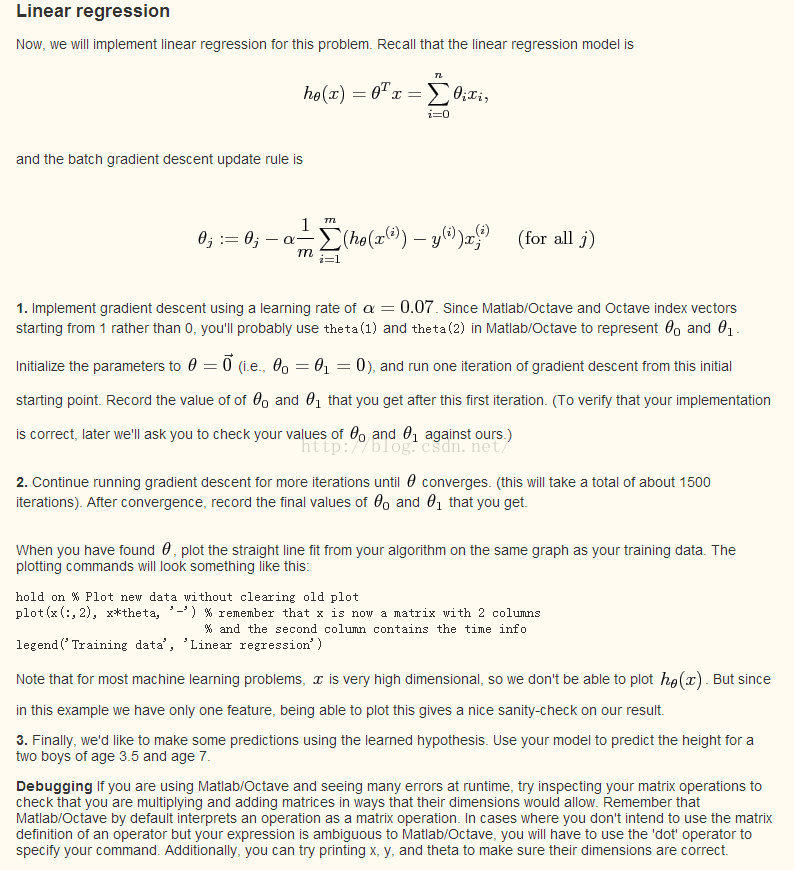机器学习&深度学习实践(python版)系列----Linear Regression(线性回归)
今天和一位师兄决定复习一下Andrew Ng的机器学习和深度学习教程理论知识,用Python实现教程中的练习。教程分为:
机器学习:http://openclassroom.stanford.edu/MainFolder/CoursePage.php?course=MachineLearning
深度学习:http://ufldl.stanford.edu/wiki/index.php/UFLDL%E6%95%99%E7%A8%8B(中文版)
我们决定从机器学习开始,逐渐实现。
写这个系列主要是方便以后学习,也是对前期学习的一个总结。欢迎大家共同讨论!
今天是第一篇:线性回归
1、理论
教程链接:http://openclassroom.stanford.edu/MainFolder/DocumentPage.php?course=MachineLearning&doc=exercises/ex2/ex2.html
具体理论就不细讲了,大家可以看教程,在这里粘贴几个重要的公式:
注意:里面的学习率设定为0.07
2、代码(python)
# -*- coding: utf-8 -*-
"""
Created on Fri Dec 11 09:55:23 2015
@author: Administrator
"""
import matplotlib.pyplot as plt
import sys
import numpy as np
"""
#加载数据
def load(file_name):
data=[]
try:
file_txt=open(file_name,"r")
except IOError:
print >> sys.stderr, "File could not be opened"
sys.exit(1)
lines = file_txt.readlines()
for line in lines:
cur_line = line.strip().split('\n')
data.append('%f4'%float(cur_line[0]))
#data.append(cur_line)
data1 = np.array(data)
file_txt.close()
return data1
"""
#加载数据
def load_data(data_name):
dataMat = []
fr = open(data_name)
for line in fr.readlines():
lineArr = line.strip().split()
dataMat.append([1.0,float(lineArr[0])])#在第一列加上1.0
return dataMat
#加载标签
def load_label(label_name):
labelMat = []
fr = open(label_name)
for line in fr.readlines():
lineArr = line.strip().split()
labelMat.append(float(lineArr[0]))
return labelMat
if __name__ == "__main__":
x = load_data(r'ex2x.dat')
#print x
y = load_label(r'ex2y.dat')
"""
plt.figure(figsize=(5,4))
plt.xlabel(r'Age in years')
plt.ylabel(r'Height in meters')
plt.title(r'Linear Regression')
plt.plot(x[1:50][1],y,'o')打印图,在此不打印了
"""
x = np.mat(x)#用np.mat转换成矩阵
y = np.mat(y).transpose()#将标签转置
m,n = np.shape(x)#获得矩阵行,列数
lr = 0.07
theat = np.mat(np.zeros(n))
for i in range(1000):#迭代次数可以设置的大些
h = np.dot(x,theat.transpose())
det_h = h-y
det_t = lr*(1.0/m)*np.dot(det_h.transpose(),x)
theat = theat-det_t
print theat3、问题集锦
由于是第一次用python编写机器学习的相关代码,因此遇到了很多问题,尤其是有关矩阵的操作,在这里和大家分享,但是我没有按照问题出现的顺序书写,顺序有点乱!
(1)TypeError: unsupported operand type(s) for *: 'builtin_function_or_method' and 'float'
解决方式:http://c.360webcache.com/c?m=bbe3fc3f97a476de966c280733f0a91b&q=TypeError%3A+unsupported+operand+type%28s%29+for+%2A%3A+%27builtin_function_or_method%27+and+%27float%27&u=http%3A%2F%2Fstackoverflow.com%2Fquestions%2F30327115%2Ftypeerror-unsupported-operand-types-for-float-and-builtin-function-or-m%2F30327327
这个问题的出现主要是在矩阵转置的时候用transpose函数时没有加上括号,如treat.transpose是错误的,treat.transpose()正确!
(2)UnicodeDecodeError: ‘ascii’ codec can’t decode byte 0xe5 in position 108: ordinal not in range
错误分析:
def load_data(data_name):
dataMat = []
fr = open(data_name)
for line in fr.readlines():
lineArr = line.strip().split()
dataMat.append([1.0,float(lineArr[0])])#在第一列加上1.0
return dataMat
错误发生在下面一句,因为lineArr是个list,float(lineArr)是错误的
dataMat.append([1.0,float(lineArr[0])])#在第一列加上1.0float()将字符串转换成浮点型,但是不能讲一个列表转换成浮点型,因此必须加上一个[0],指定将哪个元素转换成浮点型。在将字符串转换成浮点型时,如果我们想指定转换后的位数可以使用
a = '%nf'%float(str)
n就是位数。
参考链接:http://bbs.chinaunix.net/thread-2318251-1-1.html
(3)Python main函数
使用python最不习惯的一点就是不用写主函数程序就能运行。但是有一个主函数,无论是读程序还是调试程序,对我们都有帮助,其实我们可以用下面的语句定义个主函数(注意格式)
if __name__=="__main__":小实例:
<span style="font-size:18px;">#hello.py
def foo():
str="function"
print(str);
if __name__=="__main__":
print("main")
foo()</span>
参考链接:http://blog.sina.com.cn/s/blog_71a7f0870100wndd.html
(4)读取*****.dat文件
开始以为读取这个类型的文件需要自己写个函数,后来发现,读取这个类型的文件与读取****.txt文件没有什么区别。
<span style="font-size:18px;">import sys
try:
file=open("client.dat","w")
except IOError,message:
print >> sys.stderr, "File could not be opened",message
sys.exit(1)
print "Enter the accout,name and age."
while 1:
try:
accountline=raw_input("?")
except EOFError:
break
else:
print >>file,accountline
file.close()</span>
参考链接:http://blog.chinaunix.net/uid-7581503-id-2048769.html
(5)list(列表)转换成mat(矩阵)
python中使用的最多的是list,mat反而用的很少,但是一些理论推导中用的都是矩阵,所以干脆我把list转成了mat类型。
x = np.mat(x)#将list转换成mat y = np.mat(y).transpose()#将标签转置 m,n = np.shape(x)#获得矩阵行,列数 theat = np.mat(np.zeros(n))#创建一个元素为0的矩阵(6)矩阵乘法
python中计算两个矩阵的点乘用np.dot(mat1,mat2)函数
<span style="font-size:18px;">h = np.dot(x,theat.transpose())</span>
